ECU FORD E SERIES 1997 4.G Owners Manual
[x] Cancel search | Manufacturer: FORD, Model Year: 1997, Model line: E SERIES, Model: FORD E SERIES 1997 4.GPages: 192, PDF Size: 3.44 MB
Page 43 of 192
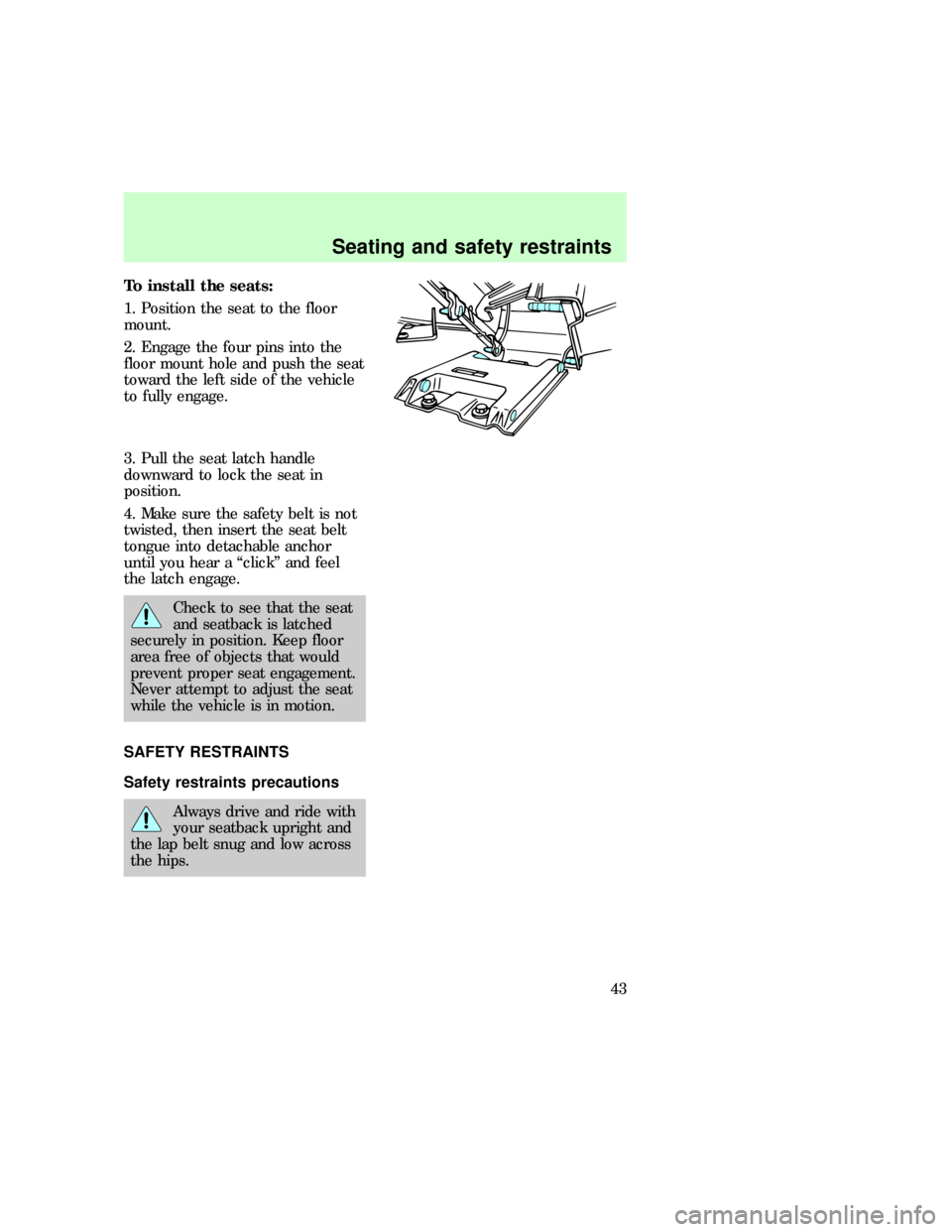
To install the seats:
1. Position the seat to the floor
mount.
2. Engage the four pins into the
floor mount hole and push the seat
toward the left side of the vehicle
to fully engage.
3. Pull the seat latch handle
downward to lock the seat in
position.
4. Make sure the safety belt is not
twisted, then insert the seat belt
tongue into detachable anchor
until you hear a ªclickº and feel
the latch engage.
Check to see that the seat
and seatback is latched
securely in position. Keep floor
area free of objects that would
prevent proper seat engagement.
Never attempt to adjust the seat
while the vehicle is in motion.
SAFETY RESTRAINTS
Safety restraints precautions
Always drive and ride with
your seatback upright and
the lap belt snug and low across
the hips.
eco_seatbelts
eco_safety-belt_precautions
Seating and safety restraints
43
Page 54 of 192
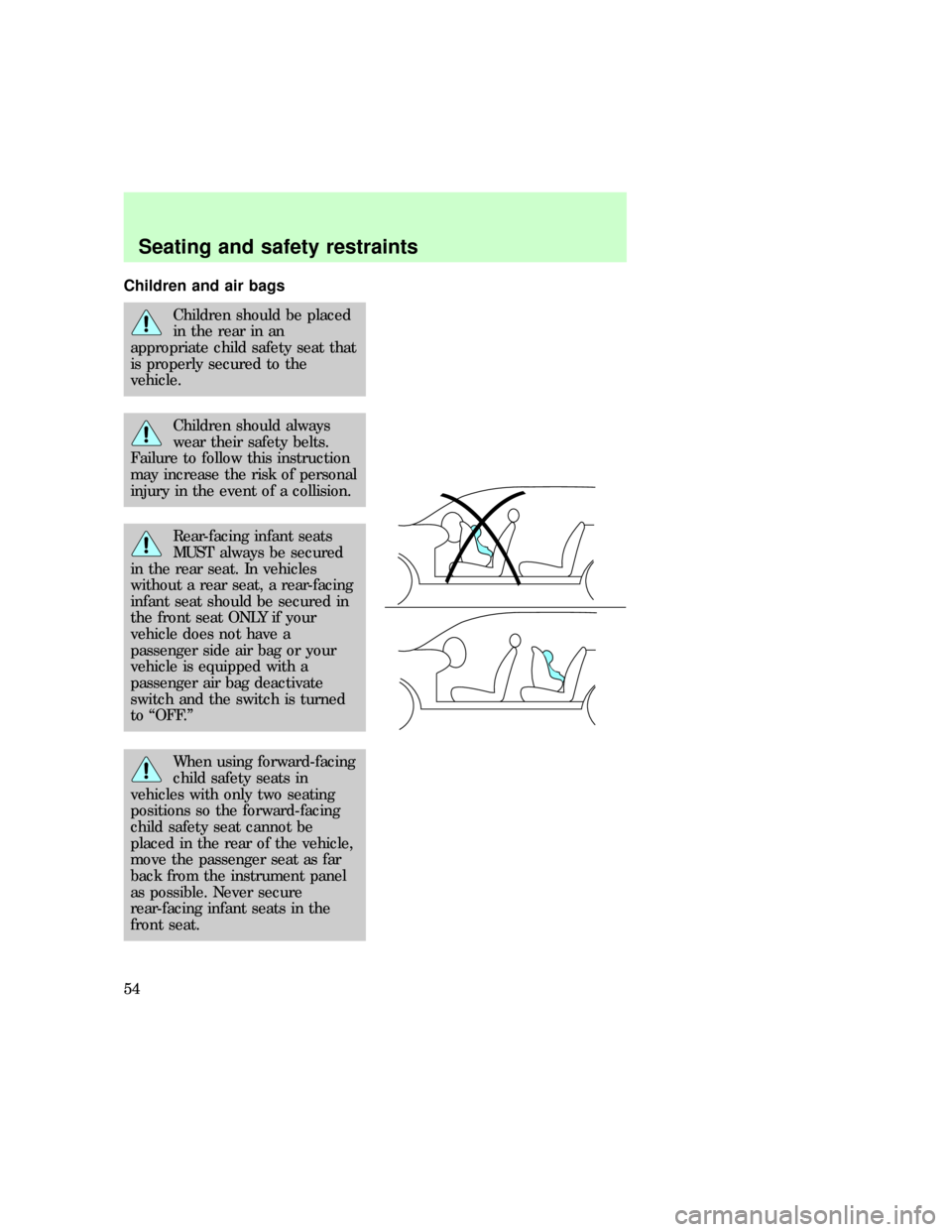
Children and air bags
Children should be placed
in the rear in an
appropriate child safety seat that
is properly secured to the
vehicle.
Children should always
wear their safety belts.
Failure to follow this instruction
may increase the risk of personal
injury in the event of a collision.
Rear-facing infant seats
MUST always be secured
in the rear seat. In vehicles
without a rear seat, a rear-facing
infant seat should be secured in
the front seat ONLY if your
vehicle does not have a
passenger side air bag or your
vehicle is equipped with a
passenger air bag deactivate
switch and the switch is turned
to ªOFF.º
When using forward-facing
child safety seats in
vehicles with only two seating
positions so the forward-facing
child safety seat cannot be
placed in the rear of the vehicle,
move the passenger seat as far
back from the instrument panel
as possible. Never secure
rear-facing infant seats in the
front seat.
Seating and safety restraints
54
Page 61 of 192
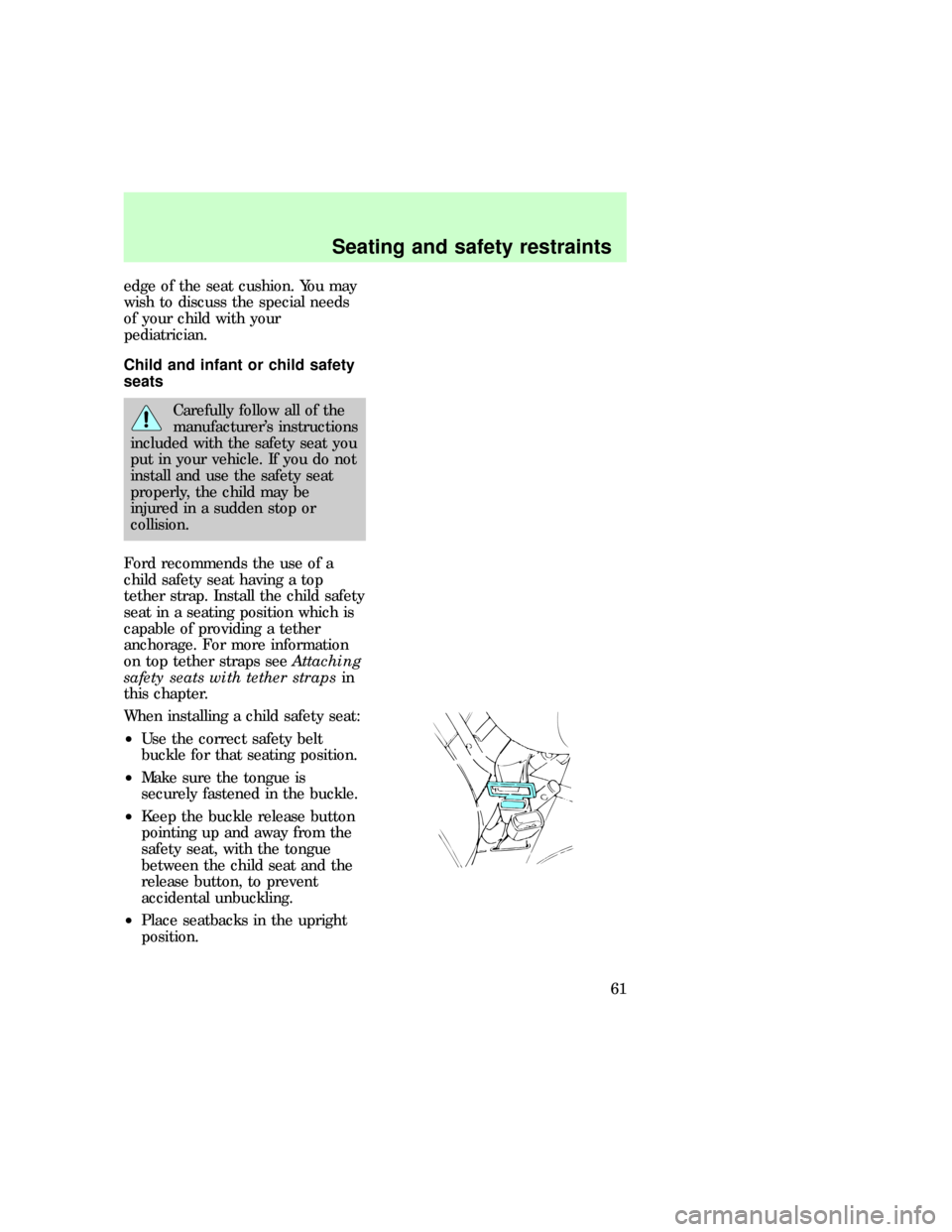
edge of the seat cushion. You may
wish to discuss the special needs
of your child with your
pediatrician.
Child and infant or child safety
seats
Carefully follow all of the
manufacturer's instructions
included with the safety seat you
put in your vehicle. If you do not
install and use the safety seat
properly, the child may be
injured in a sudden stop or
collision.
Ford recommends the use of a
child safety seat having a top
tether strap. Install the child safety
seat in a seating position which is
capable of providing a tether
anchorage. For more information
on top tether straps seeAttaching
safety seats with tether strapsin
this chapter.
When installing a child safety seat:
²Use the correct safety belt
buckle for that seating position.
²Make sure the tongue is
securely fastened in the buckle.
²Keep the buckle release button
pointing up and away from the
safety seat, with the tongue
between the child seat and the
release button, to prevent
accidental unbuckling.
²Place seatbacks in the upright
position.
com_safety_seats.01
Seating and safety restraints
61
Page 64 of 192
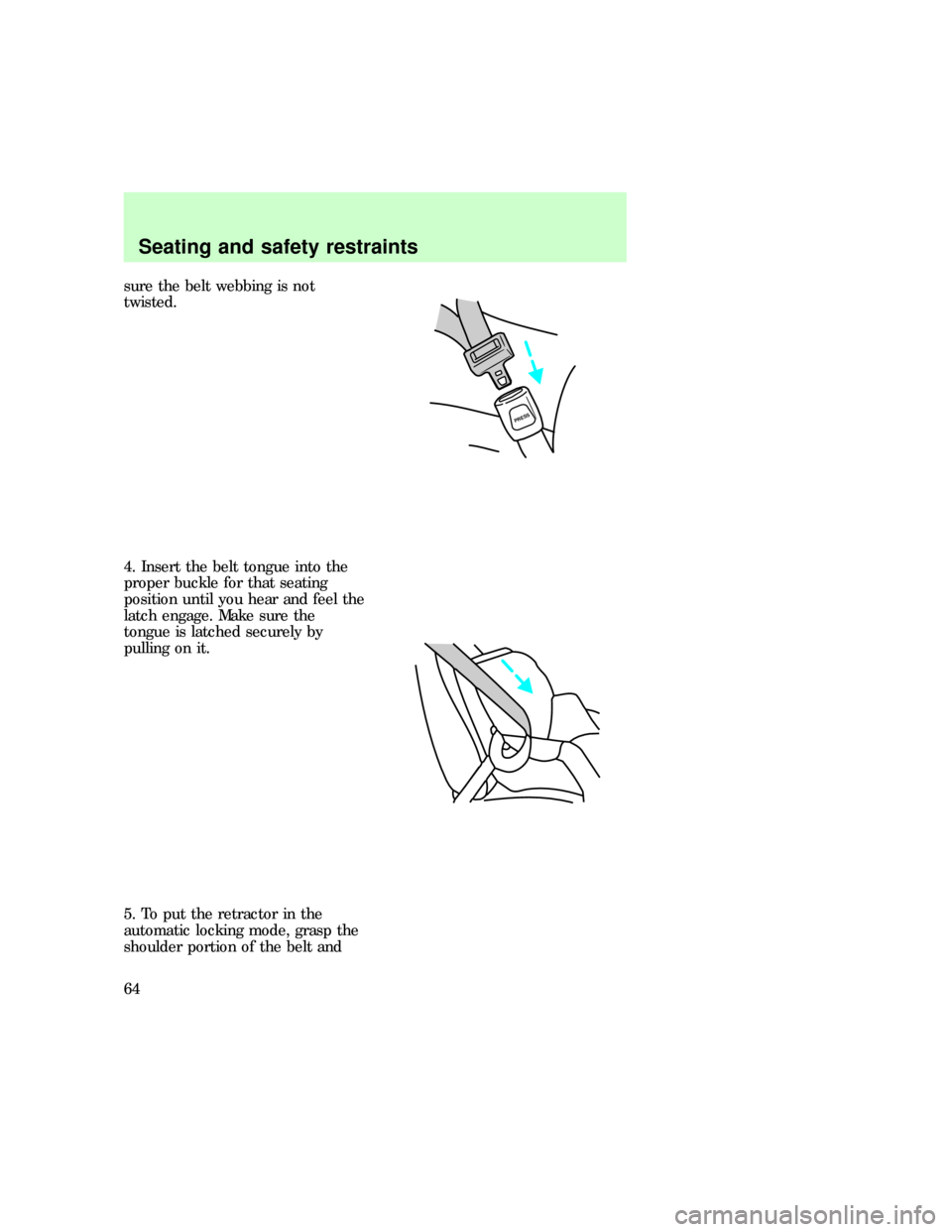
sure the belt webbing is not
twisted.
4. Insert the belt tongue into the
proper buckle for that seating
position until you hear and feel the
latch engage. Make sure the
tongue is latched securely by
pulling on it.
5. To put the retractor in the
automatic locking mode, grasp the
shoulder portion of the belt and
PRESS
Seating and safety restraints
64
Page 65 of 192
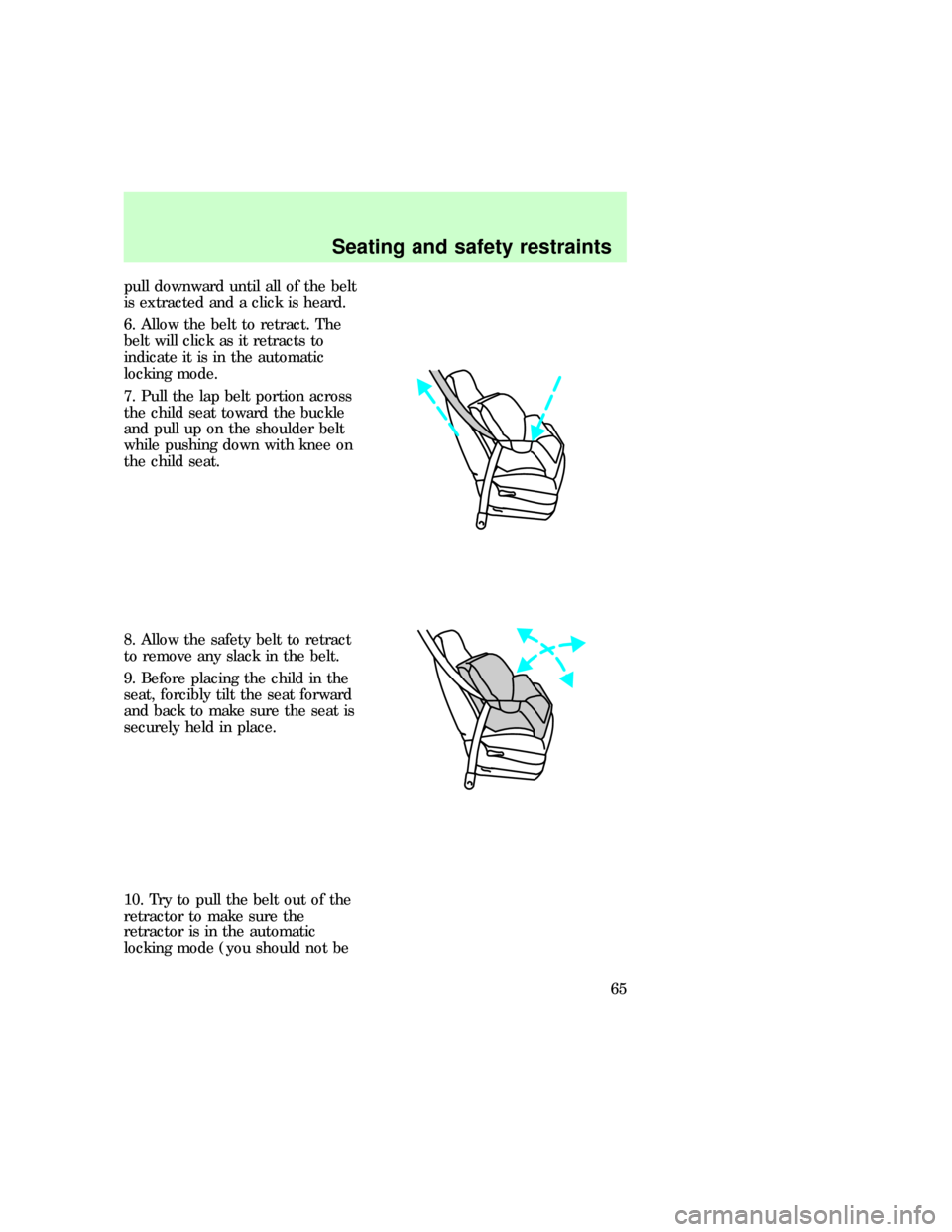
pull downward until all of the belt
is extracted and a click is heard.
6. Allow the belt to retract. The
belt will click as it retracts to
indicate it is in the automatic
locking mode.
7. Pull the lap belt portion across
the child seat toward the buckle
and pull up on the shoulder belt
while pushing down with knee on
the child seat.
8. Allow the safety belt to retract
to remove any slack in the belt.
9. Before placing the child in the
seat, forcibly tilt the seat forward
and back to make sure the seat is
securely held in place.
10. Try to pull the belt out of the
retractor to make sure the
retractor is in the automatic
locking mode (you should not be
Seating and safety restraints
65
Page 66 of 192
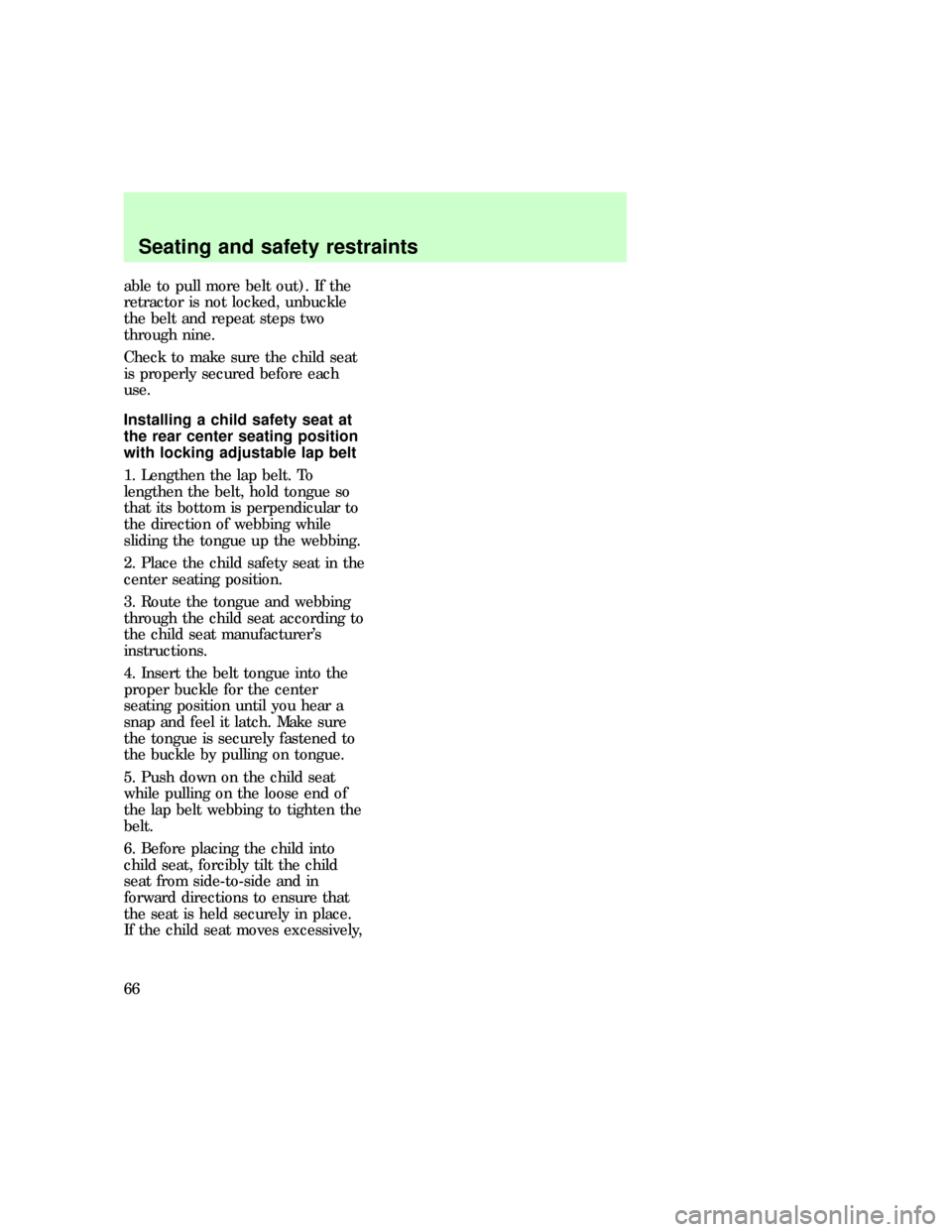
able to pull more belt out). If the
retractor is not locked, unbuckle
the belt and repeat steps two
through nine.
Check to make sure the child seat
is properly secured before each
use.
Installing a child safety seat at
the rear center seating position
with locking adjustable lap belt
1. Lengthen the lap belt. To
lengthen the belt, hold tongue so
that its bottom is perpendicular to
the direction of webbing while
sliding the tongue up the webbing.
2. Place the child safety seat in the
center seating position.
3. Route the tongue and webbing
through the child seat according to
the child seat manufacturer's
instructions.
4. Insert the belt tongue into the
proper buckle for the center
seating position until you hear a
snap and feel it latch. Make sure
the tongue is securely fastened to
the buckle by pulling on tongue.
5. Push down on the child seat
while pulling on the loose end of
the lap belt webbing to tighten the
belt.
6. Before placing the child into
child seat, forcibly tilt the child
seat from side-to-side and in
forward directions to ensure that
the seat is held securely in place.
If the child seat moves excessively,
eco_chils_seat_lap-belt
Seating and safety restraints
66
Page 67 of 192
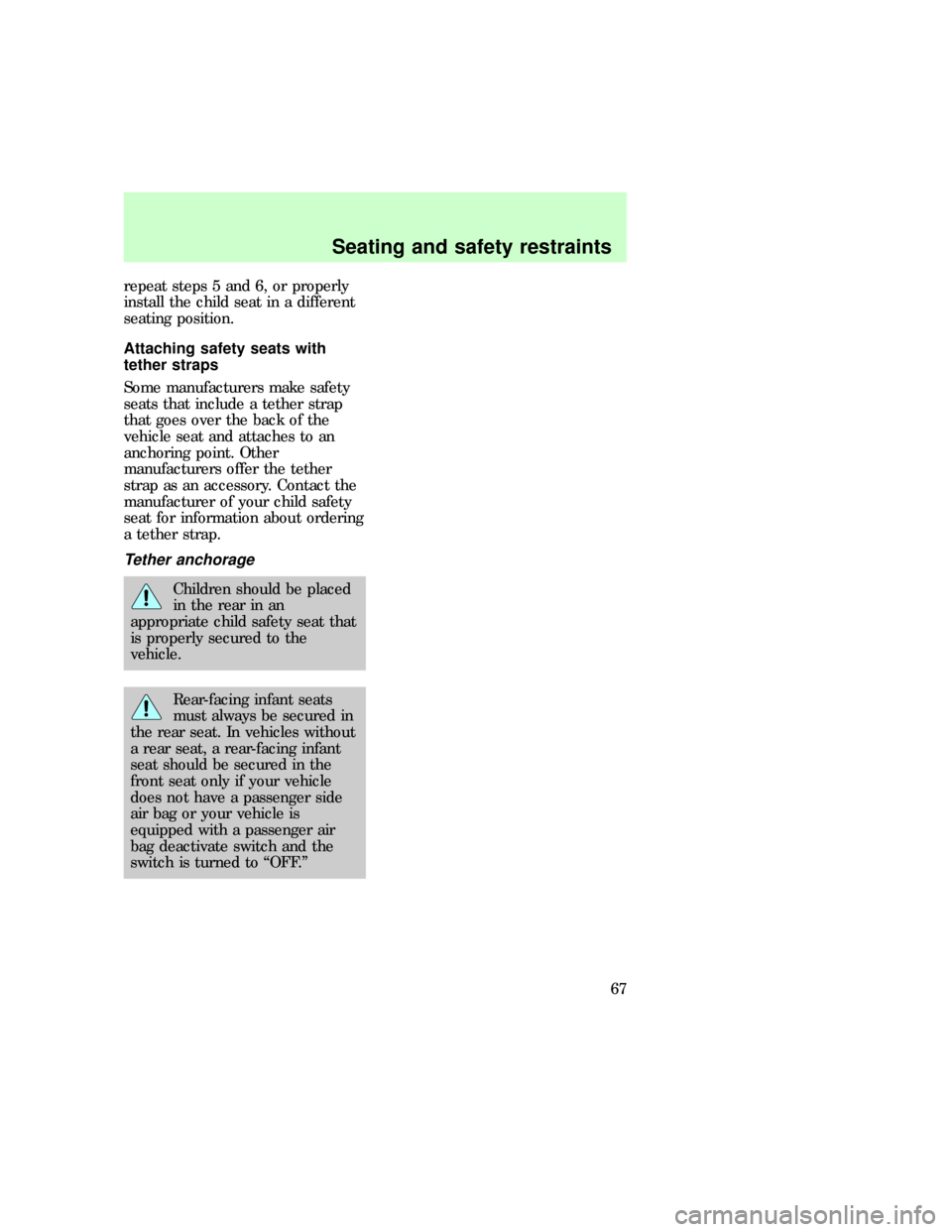
repeat steps 5 and 6, or properly
install the child seat in a different
seating position.
Attaching safety seats with
tether straps
Some manufacturers make safety
seats that include a tether strap
that goes over the back of the
vehicle seat and attaches to an
anchoring point. Other
manufacturers offer the tether
strap as an accessory. Contact the
manufacturer of your child safety
seat for information about ordering
a tether strap.
Tether anchorage
Children should be placed
in the rear in an
appropriate child safety seat that
is properly secured to the
vehicle.
Rear-facing infant seats
must always be secured in
the rear seat. In vehicles without
a rear seat, a rear-facing infant
seat should be secured in the
front seat only if your vehicle
does not have a passenger side
air bag or your vehicle is
equipped with a passenger air
bag deactivate switch and the
switch is turned to ªOFF.º
eco_tether-straps
eco_tether_anchorage
Seating and safety restraints
67
Page 71 of 192
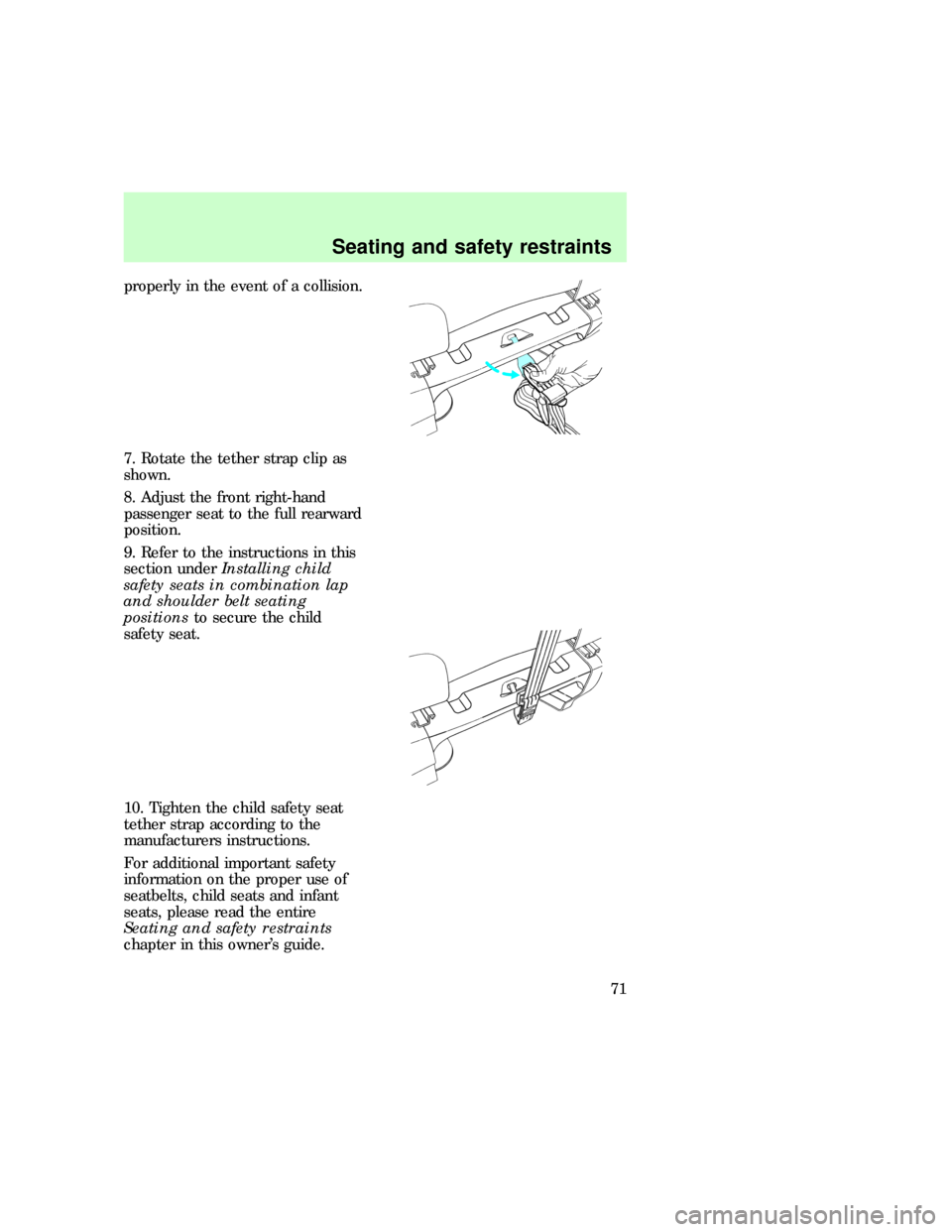
properly in the event of a collision.
7. Rotate the tether strap clip as
shown.
8. Adjust the front right-hand
passenger seat to the full rearward
position.
9. Refer to the instructions in this
section underInstalling child
safety seats in combination lap
and shoulder belt seating
positionsto secure the child
safety seat.
10. Tighten the child safety seat
tether strap according to the
manufacturers instructions.
For additional important safety
information on the proper use of
seatbelts, child seats and infant
seats, please read the entire
Seating and safety restraints
chapter in this owner's guide.
Seating and safety restraints
71
Page 114 of 192
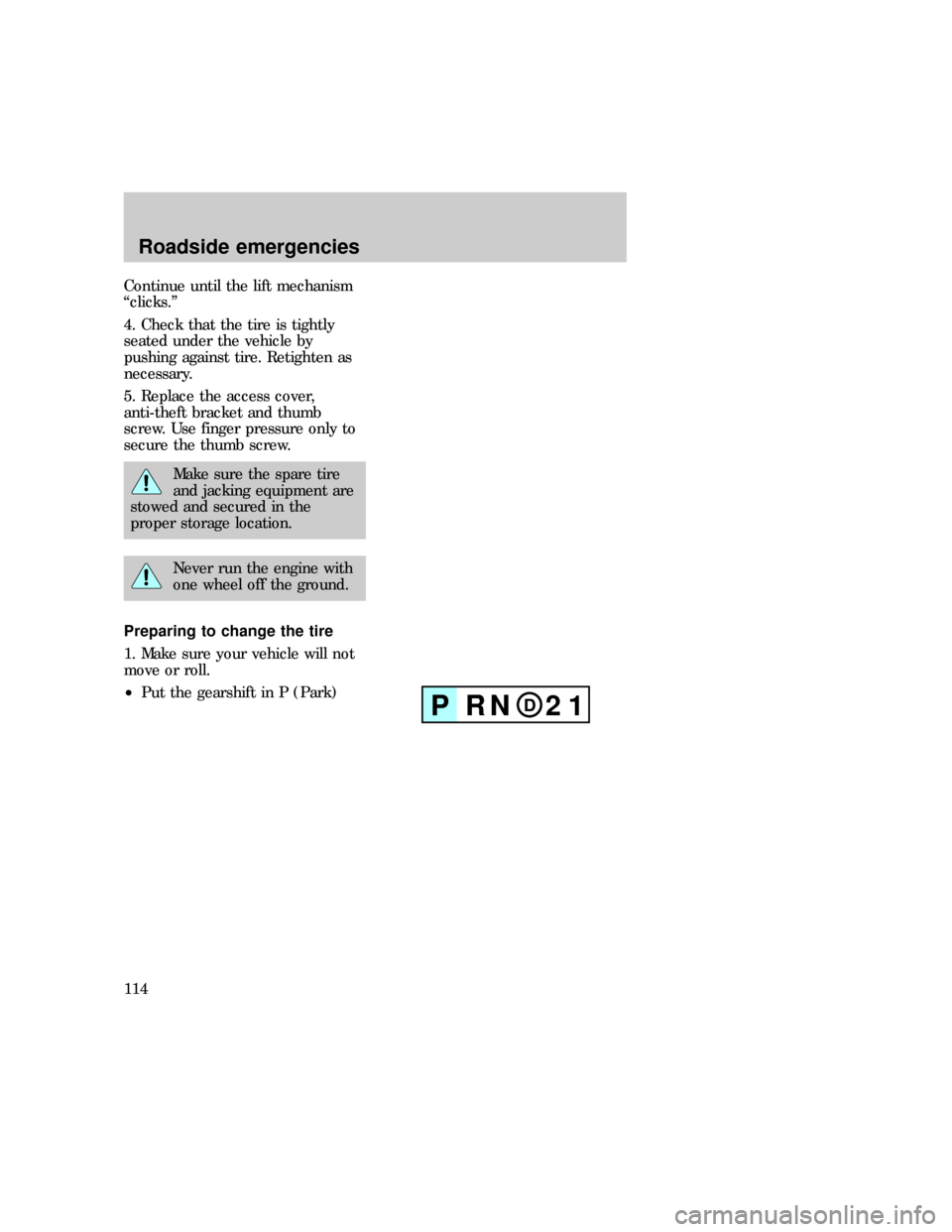
Continue until the lift mechanism
ªclicks.º
4. Check that the tire is tightly
seated under the vehicle by
pushing against tire. Retighten as
necessary.
5. Replace the access cover,
anti-theft bracket and thumb
screw. Use finger pressure only to
secure the thumb screw.
Make sure the spare tire
and jacking equipment are
stowed and secured in the
proper storage location.
Never run the engine with
one wheel off the ground.
Preparing to change the tire
1. Make sure your vehicle will not
move or roll.
²Put the gearshift in P (Park)
DPRN 21
eco_preparing_tire_change
Roadside emergencies
114
Page 126 of 192
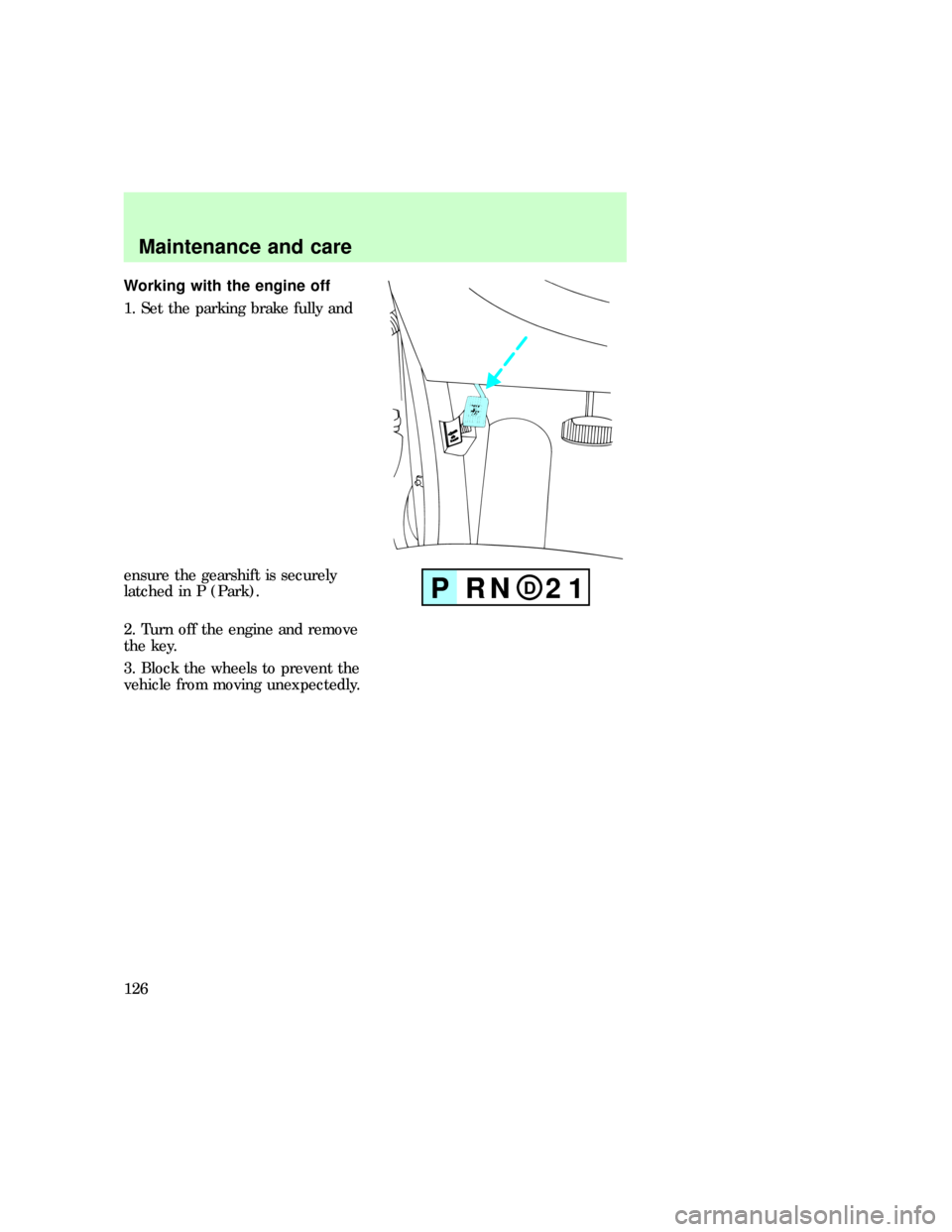
Working with the engine off
1. Set the parking brake fully and
ensure the gearshift is securely
latched in P (Park).
2. Turn off the engine and remove
the key.
3. Block the wheels to prevent the
vehicle from moving unexpectedly.
DPRN 21
com_working_on.01
Maintenance and care
126